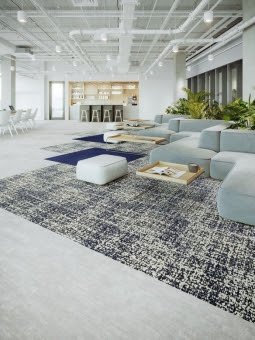by Brianna Crandall — May 25, 2022 — In one of the first surveys of its kind, design firm HOK and flooring manufacturer Tarkett asked neurodiverse individuals in the U.S., UK and Canada to share how their work environments could better cater to their jobs and personal needs. Genius Within, an organization dedicated to helping neuro-minorities maximize their potential, provided advisory services as the team built on in-depth research and insights by HOK and the commercial interiors color specification guide developed by Tarkett to help businesses design for inclusion.

Along with acoustics, a floor’s color, pattern, texture and wayfinding elements play a key role in supporting neurodivergent groups to improve their overall experience of the interior environment. Image courtesy of Tarkett
Neurodiversity refers to variations in human neurocognitive functioning — the different ways we think, process information, and relate to others. One in seven people worldwide are estimated to have a neurodiverse condition such as ADHD, autism, dyspraxia, dyslexia or Tourette’s syndrome, according to the survey.
HOK and Tarkett’s survey collected feedback from 202 neurodiverse individuals, with a focus on women and workers older than 30, two groups that they say have been largely underrepresented in other studies on neurodiversity.
The survey found several challenges these individuals face when it comes to workplaces. A few of those include:
- 77% of respondents reported being hypersensitive to noise and sound in the workplace.
- 62% of respondents were hypersensitive to visual distractions (movement, color, light) in the office.
- Women reported greater overall sensory sensitivity challenges in the workplace compared to men, particularly when it came to temperature and light (62% and 59% compared to 46% and 44%, respectively).
Insights from the survey can help workplace designers and product manufacturers create spaces that are more supportive and inclusive for neurodiverse employees. Survey respondents specifically identified the following workplace strategy and design solutions employers could consider:
- Offer training and education about neurodiversity to all staff;
- Offer all employees (neurodiverse and neurotypical) a variety of workplace choices, from open office environments to private, to address various sensory stimulations;
- Provide spaces that support and encourage physical movement and access to natural light; and
- Create flexible work policies that give people autonomy over their schedule and work environment, including work-from-home opportunities when feasible.
Kay Sargent, director of workplace for HOK, commented:
One size, or solution, misfits all. This latest study continues to show that, to allow all employees to thrive, office designs need to remain fluid and adaptable. Employers can improve employee wellness and productivity by offering a wide range of choices, allowing people to continually select the best space for their individual needs and the task at hand.
While the pandemic has normalized hybrid work and encouraged a wider conversation around employee well-being, the HOK/Tarkett survey suggests opportunities still exist for organizations to do more to support their employees.
Leslie Thompson, director of Workplace for Tarkett North America, stated:
Neurodiverse employees bring valuable diversity of thought and competitive advantage to their organizations. Optimizing the work environment to support each individual isn’t just the right thing to do for our people; it’s simply good business.
A report of the Designing for Neurodiversity survey findings is available for download from the Tarkett website.
HOK designs buildings and spaces to respond to the needs of people and the environment. HOK designers are rooted in technical excellence, driven by imagination and focused on a solitary goal: to deliver solutions that inspire clients and communities.
With a history of 140 years, Tarkett is a worldwide provider of innovative flooring and sports surface solutions. Offering a wide range of products including vinyl, linoleum, rubber, carpet, wood, laminate, artificial turf and athletics tracks, the Group serves customers in over 100 countries across the globe. Tarkett has 12,000 employees and 34 industrial sites, and reportedly sells 1.3 million square meters of flooring every day for hospitals, schools, housing, hotels, offices, stores and sports fields. Committed to change the game with circular economy and to reducing its carbon footprint, the Group has implemented an eco-innovation strategy based on Cradle to Cradle principles, fully aligned with its Tarkett Human-Conscious Design approach.




